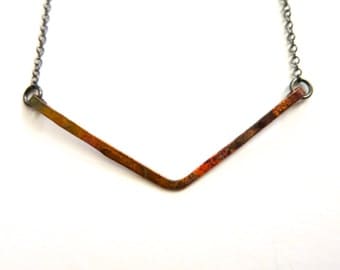
#JEWELRY PATINA DEFINITION HOW TO#
Now you know how to patina copper, using Liver of Sulphur, you can experiment with the method to define more intricately stamped/etched pieces and create that popular antique look with ease. This is because the patina solution clings to the indentations, making them more prominent while simultaneously creating an aged look. This technique works especially well where you’ve created textured, patterned pieces, or pieces with stamped or etched designs. This will protect your work, keeping the darker, oxidised areas of your pieces dark, and the lighter, shinier surfaces untarnished. Then apply to your finished copper piece. Simply apply a small amount of the wax to a dry cloth (a little goes a long way).

The artificial antique effect created by your Liver of Sulphur solution can be protected by applying renaissance wax. Now leave to dry.īefore learning how to protect patina on copper, you’ll need to pick up some renaissance wax. You can apply as little or as much pressure as you like for your desired effect. To achieve the desired aging effect on your copper pieces, use some wire wool, a brass brush, or an old polishing cloth to remove the excess copper patina solution. Remember to avoid touching the pieces where possible. Dip it into a separate tub of water or rinse away under a cold tap. Once removed you’ll need to rinse the piece in water.Once you can see that the copper metal has turned black, you can remove the piece using your plastic tweezers or using the metal wire trick as mentioned above. Avoid storing with food or clothing as the smell of sulphur may linger. Once re-sealed the Liver of Sulphur should be stored in a dry cool place, away from direct sunlight. Re-seal the Liver of Sulphur container.That way, it’s easy to remove and you’re less likely to spill any of the solution. One common trick to avoiding any spillages is to hang your copper metal using excess metal wire and dropping it into the solution with the wire sticking up out of the solution. If the container you’ve mixed your patina solution in is fairly deep, it may be difficult to remove the pieces with your tweezers without getting the Liver of Sulphur solution on your clothing or your surroundings. Now you’re ready to place your copper into the solution. Mix the dry form Liver of Sulphur into the hot water until it dissolves.This is because a patina solution that is too concentrated may cause the patina to flake off. Only a small amount of liver of sulphur is required for the desired aging effect. Wearing rubber gloves, remove the required amount of dry form Liver of Sulphur with your tweezers and carefully add to the water. Add the water to your plastic mixing container or bowl. There’s no need for the water to be boiling hot – warm will do. Dry form Liver of Sulphur is dissolved in warm water to create your copper patina solution. How to make patina solution with Liver of Sulphur
#JEWELRY PATINA DEFINITION SKIN#
This will protect your skin from the chemical solution.

Do you have a set of plastic or stainless-steel tools at the ready? You’ll need these to remove items from the liver of sulphur solution. If you’re new to creating pickling solutions use our step by step guide on how to make pickle and the precautionary measures you’ll need to take to use the chemical solution. Once clean, avoid handling the copper directly to avoid oil being transferred to the sheet. Once cleaned, remove from the solution with your tweezers and rinse. Now carefully place your copper into the solution using plastic tweezers. Make your pickling solution and gently heat it to speed up the cleaning process. If it’s not completely finished and polished, and the liver of sulphur is applied and followed up with more filing and polishing, it’s likely that the patina finish will be compromised.

Here’s our top tips for preparing your work: That being said, it’s also worth avoiding a completely satin finish as this leaves less for the copper patina solution to cling onto. For the best possible results, always clean the copper you’re working with to remove any fingerprints, excess debris or oil. These include:īefore you learn how to patina copper, the best place to start is by prepping the pieces you’re working with.

When learning how to patina copper sheets, there are a few key pieces of kit that you’ll need.


 0 kommentar(er)
0 kommentar(er)
